EARTHQUAKES IN THE TOKYO AND OSAKA AREAS IN THE 2000s
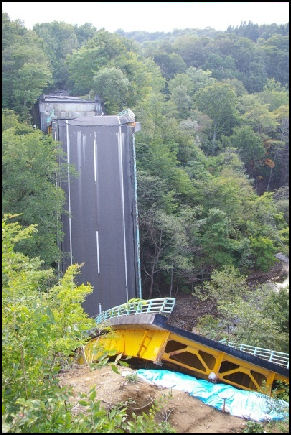
Iwate Miyage 2008 In September 2004, two strong earthquakes — one measuring 6.9 and other 7.3 on the Richter scale — hit western Japan within hours of each other, injuring 14 people, shaking buildings in Osaka, Nagoya and Tokyo. Damage was minimal because both were off the coast of sparsely-populated Wakayama Prefecture.
In July 2005, an earthquake measuring 6.0 on the Richter scale struck the Kanto region, injuring 22 in Tokyo and Kanagawa, Chiba and Saitama prefectures near Tokyo. It was the strongest quake in the area since 1992. The quake affected train service. Some people were trapped in elevators. A steel tower was toppled in Edogawa Ward in Tokyo. The people that were injured were mostly hurt by falling signs and pachinko machines.
In April 2005, an earthquake measuring 6.1 on the Richter scale struck Chiba and Ibaraki prefectures near Tokyo. The quake affected train service. Some homes lost power. No one was killed or seriously injured.
In August 2009, an earthquake measuring 6.6 on the Richter scale rocked Hachijojima Island, 280 kilometers south of Tokyo. There was no tsunami an no reports of injuries
See Separate Articles:EARTHQUAKES AND JAPAN factsanddetails.com ; EARTHQUAKES: GEOLOGY, FREQUENCY, TYPES, ENERGY AND RESEARCH factsanddetails.com ; LARGE EARTHQUAKES IN JAPAN factsanddetails.com ; GREAT TOKYO EARTHQUAKE OF 1923 factsanddetails.com ; KOBE EARTHQUAKE OF 1995 factsanddetails.com ;
Good Websites and Sources: U.S. Geological Survey (USGS) National Earthquake Information Center earthquake.usgs.gov ; Wikipedia article on Earthquakes Wikipedia ; Earthquake severity pubs.usgs.gov ; Collection of Images from Historic Earthquakes Pacific Earthquake Engineering Research Center, Jan Kozak Collection ; World Earthquake Map iris.edu/seismon Most Recent Earthquakes earthquake.usgs.gov ; Earthquake Pamphlet pubs.usgs.gov ; USGS Earthquakes for Kids earthquake.usgs.gov/learn/kids ; Earthquake Preparedness and Safety Surviving an Earthquake edu4hazards.org ; Earthquake Preparedness Guide earthquakepreparednessguide.com ; Earthquake Safety Site earthquakecountry.info
Earthquake Information for Japan Earthquake Information from Japan Meteorological Agency jma.go.jp/en/quake ; F-Net Broadband Seismography Network fnet.bosai.go.jp ; Wikipedia List of Earthquakes in Japan Wikipedia ; Major Earthquakes in Japan in the 20th Century drgeorgepc.com ; Earthquake Engineering and Disaster Prevention: Disaster Prevention Research Institute, University of Kyoto dpri.kyoto-u.ac.jp/web ; Japan Association of Earthquake Engineering jaee.gr.jp/english ; Earthquake Preparedness in Japan Earthquake Preparedness Survey whatjapanthinks.com ; Earthquake Research in Japan: Headquarters of Earthquake Research Promotion jishin.go.jp ; Institute of Geology and Geoinformation unit.aist.go.jp Research Center for Earthquake Prediction, University of Kyoto rcep.dpri.kyoto-u.ac.jp ; Earthquake Research Institute, University of Tokyo eri.u-tokyo.ac.jp ; 1923 Tokyo Earthquake: Great Kanto earthquake of 1923 dl.lib.brown.edu/kanto ; 1923 Tokyo Earthquake Photo Gallery japan-guide.com
Recent Earthquakes
In February 2011, 28 Japanese students studying at an English school were killed in a 6.3-magnitude earthquake in Christchurch, New Zealand that caused the building their school was located in — the CTV Building — to collapse.
In February 2010, an earthquake measuring 6.9 on the Richter scale struck Okinawa. It was the strongest quake to strike the island since 1909. Two people sustained minor injuries.
See March 2011 Earthquake and Tsunami
Shizuoka Earthquake in 2009
In August 2009, a large earthquake measuring 6.5 on the Richter hit Shizuoka south of Tokyo, killing one person and injuring 123. Three prefectures reported damaged, with 5,188 of the 5,192 damaged buildings in Shizuoka Prefecture and the other four in Nagano Prefecture. More than half the injures were caused by falling furniture, with at least one serious injury caused by falling large-screen television. The quake occurred at 5:00am. Some initially thought it was the first temblor of the dreaded Tokai earthquake but that was not the case. An alert system failed to pick up the quake.
The worst damage was the collapse of a 100-meter section of the Tomei Expressway, a major transportation link on the Tokyo-Osaka corridor. Drivers were forced to take alternative roads and these became jammed with drivers traveling during the Bon holiday season, when roads are packed anyway. Repair work that was supposed to take a few days took more than a week, and virtual gridlock prevailed until the expressway reopened.
The epicenter of the Shizuoka earthquake was in Suruga Bay which is where the epicenter of the Tokai earthquake is expected to occur. One man who was evacuated from his home told the Yomiuri Shimbun, “Violent shaking woke me up. I rushed to the second floor to save my two daughters. The TV moved, and the roof tiles fell off. I was relieved no one was hurt.” A 74-year-old man living nearby said, “I thought it was the Tokai earthquake, A chest of drawers tipped over and would have crushed me if I’d been sleeping.”
Earthquakes in Miyagi
Miyagi Prefecture in northeast Honshu is one of the most earthquake prone areas in Japan. An earthquake in May, 1983 killed more than 100 people, including a group of elementary school children swallowed up by a tsunami.
In 1978, an earthquake measuring 7.4 on the Richter scale struck just off Japan’s northeast coast in Miyagi Prefecture, killing 28 people and injuring more than 1,325 in Sendai and neighboring areas. Afterwards scientists said earthquakes of 7.0 or above have occurred on average every 37 years along the fault that runs along the coast in Miyagi prefecture and there was a 99 percent chance of magnitude 7.5 earthquake occurring in the region within 30 years. The earthquake in August 2005 was “not the big one,” scientists said.

Miyagi area On May 26, 2003, a large earthquake occurred off the coast of Miyagi Prefecture, 220 miles northeast of Tokyo. Measuring 7 on the Richter scale, it caused widespread damage and injured 120 but didn’t kill anyone. There were some fires. More than 500 people were stranded all night in Shinkansen trains. The damage consisted mostly of stuff falling off shelves and cracks found in the pillars that support the Shinkansen. The epicenter was off the coast.
On July 26, 2003, a strong series of earthquakes rocked Miyagi Prefecture near where the May 26 earthquake occurred. The first quake measured 5 on the Richter scale. It was followed by about 1,000 aftershocks, including ones that measured 6.2 and 5.3 on the Richter scale. No one was killed but around 570 people were injured, 400 houses were destroyed or badly damaged and over 5,300 were partly damaged. Power supplies were cut off to 100,000 homes and some people sought shelter in school gymnasiums. Some roads were blocked and trains were derailed.
The July 2003 earthquakes occurred along an inland fault. Although the earthquakes were not overwhelmingly strong, they had the highest accelerations rates ever observed in an earthquake. High acceleration results in high rates of destruction at ground level. In some places there were large fissures in the landscape.
In August 2005, an earthquake measuring 7.2 on the Richter scale struck just off Japan’s northeast coast, in Miyagi Prefecture about 300 kilometers north of Tokyo, injuring at least 67 people. Homes collapsed; buildings were damaged; pachinko machines and stone lanterns fell on people; Shinkansen trains stopped; high-rises in Tokyo swayed. Twenty-six of the injuries occurred when the ceiling of an swimming pool came crashing down in pieces. The quake originated about 50 kilometers offshore at a depth 42 kilometers beneath the ocean surface. Tsunami warnings were broadcasts but no tsunami occurred. The highest earthquake readings on land were in the low 6s.
Iwate-Miyagi Earthquake in 2008
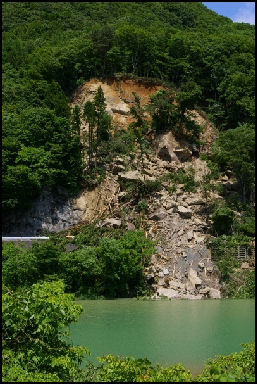 In June 2008, an earthquake measuring 7.2 on the Richter scale struck areas of Iwate and Miyagi Prefectures in northern Honshu, killing 23 (15 confirmed dead and eight unaccounted) and injuring more than 257. Known in Japan as the Iwate-Miyagi Inland earthquake, it caused violent up-and-down shaking that lasted for about two minutes. Akita, Fukushima and Yamagata Prefectures were also affected.
In June 2008, an earthquake measuring 7.2 on the Richter scale struck areas of Iwate and Miyagi Prefectures in northern Honshu, killing 23 (15 confirmed dead and eight unaccounted) and injuring more than 257. Known in Japan as the Iwate-Miyagi Inland earthquake, it caused violent up-and-down shaking that lasted for about two minutes. Akita, Fukushima and Yamagata Prefectures were also affected.
The reverse fault earthquake occurred along a near-field active fault as was the case with the Kobe earthquake in 1995. The focus was about eight kilometers underground on a fault eight kilometers southeast of Oshu. A vertical displacement of 40 to 50 centimeters occurred on the surface. The worst hit areas were around Kurihara, Miyagi Prefecture and Ichinoseki and Oshu in Iwate Prefecture. National Highway Route 398 was broken into pieces by a series of landslides that left some places with collapsed roads dropping off cliffs of dirt.
Houses were destroyed. Water pipes burst. Elevators and escalator came to sudden stops. Concrete fell from buildings. People were injured by falling glass. Villagers were cut off by landslides and pulled out by helicopters. Shinkansen service in the area was suspended. Radioactive water leaked at the Fukushima No. 2 nuclear power plant. Landslides near Ishibuchi dam in Miyagi Prefecture caused a tour bus carrying 20 passengers to slide 50 meters down a slope. Another traveling across a bridge with 27 people on board got a rude shaking. Military personnel were dispatched to the area to help out.
A man who was mountain climbing near Ishibuchi dam near Oshu told the Yomiuri Shimbun, “I’d been climbing for about 30 minutes when water suddenly gushed out like a fountain from the middle of swamp. I thought I was going to die but I managed to get back to the bottom after an hour.” A teacher at a nursery school where children were hurt by flying glass said, “As soon as I realized it was an earthquake, we were hit by a strong shock. The windows smashed, and the children got scared and started crying.”
Surprisingly the damage to buildings was relatively minor. This was due to they type of shaking that occurred and the fact that house in the region are sturdily built to stand up to heavy snowfall.
Deep Landslide from the Iwate-Miyagi Earthquake in 2008
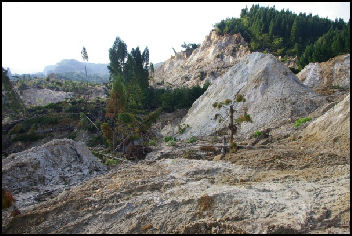
A huge, deep landside near the Aratozawa dam in Kurihara, Miyagi Prefecture reshaped the contour of a mountain to look as if part of the earth’s surface had fallen inside the earth. More than 70 million cubic meters of earth — enough to fill a large domed area like the Tokyo Dome 56 times — is believed to have collapsed. Around 1.5 million cubic meters fell into the reservoir behind the Aratozawa dam.
A deep landside is when large amounts of earth completely collapse from a point deep in the mountain slope. It is often caused by tremors that seem to thrust up from below, causing the pressure of underground water to rise, making the ground above the water float before abruptly collapsing. Japanese mountains contain a lot of water . The water acts as a lubricant when earthquakes occur, causing landslides that can sheer off entire mountain slopes.
The landslide caused widespread damage and destroyed roads. It is believed to have been partly caused by underground water backed up by the Aratozawa dam. On the reservoir a three-meter-high tsunami-like wave was generated.
Forty-eight major landslides were counted in the quake-hit area around Kurihara, with 18 of them blocking Route 398. Landslides also blocked rivers, creating 11 dams and quake lakes on the Nihasamagawa, Hasamagawa and Iwaigawa rivers. Hot gas and steam began emerging from Mt. Kurikoma, a 1,627-meter-high active volcano that lies on the border of Iwate, Miyage and Akita prefectures.
Landslides from earthquake created quake lakes like those in China after the Sichuan earthquake. Hundreds of residents were ordered to leave one village below a landslide-produced dam and lake on the Hanayama River that seemed dangerously close to collapsing.
Dead, Missing and Compensation in the Iwate- Miyagi Earthquake in 2008
Among those missing were a couple visiting waterfall in Kurihara, Miyagi Prefecture. They were last seen near a suspension foot bridge. Some have speculate they may have been knocked off the suspension bridge which lies about 10 meter above a stream and carried downstream and buried under a landslide.
Landslides on National Highway Route 398 in Kurihara left two construction workers dead and one missing. A man fishing on a lake was killed by a landslide. A worker was killed by falling rocks at a dam construction site on Oshu. Another person was killed when his car was buried by a landside.
Seven people — including owners and guests — were killed at the Komanoyu Onsen inn in Kurihara. Landslides pushed the inn 50 meters and spun it around. A survivor who was pulled from the rubble told the Yomiuri Shimbun, “There was tremendous shaking and it felt like the floor was being lifted up...The building was crushed with overwhelming power. It’s a miracle I was rescued. I can’t believe I’m here now.”
The man — Akio Sugawara, a member of the family that owned the inn’said after the quake struck, co-workers were yelling the building was collapsing. When he went outside he saw the cliff face facing the inn was crumbling and a stream flowing 30 metes below was rising rapidly. Ten minutes later a landside occurred with a deafening roar. At that moment he ran in the building as it collapsed. He saw his mother buried by rubble and himself was trapped between a wall and debris with broken ribs and feet. He managed to clamber up the debris and locate a mobile phone and call for help and was rescued by nearby residents who waded through hip-deep mud to reach him.
Families whose houses were destroyed received $30,000 in emergency aid. Those who stayed in temporary housing for many months received $8,000 to $20,000 according to the size of their family, people whose businesses were affected received $5,000 to $20,000 while those who lost their jobs because of the quake got $5,000. In Koei district up to $100,000 was given to people whose farms were damaged.
Tohuko Earthquake in 2008
In July 2008, an earthquake measuring 6.8 on the Richter scale struck Pacific coastal areas of the Tohuko region in northern Honshu and Hokkaido, killing one, injuring 126 people — 28 seriously — and blocking roads with landslides and damaging 244 buildings. The epicenter was near Hironocho, Iwate Prefecture, a sparsley-populated, mountainous area, and the focus was unusually deep — 108 kilometers under the surface. The quake was related to the subduction of the Pacific plate and occurred relatively close to June 2008 earthquake in Miyagi but appears to have not been related.
Witnesses near the epicenter said there were strong vertical vibrations, followed by horizontal tremors that seemed to last more than a minute. The vibrations were high frequency which cause less damage than low frequency ones. Landslides occurred over a wide area. Power was temporarily cut off to thousands of homes. Hundreds were trapped on halted trains, some overnight.
The earthquake occurred at 12:26am. Television images showed offices strewn with papers and houses with broken glass and fallen roof tiles. One government official told the New York Times, “I woke up immediately. It felt like it was shaking for a long time. Books and other things that were piled up fell on the floor. All the doors were open and things were shattered.”
Many people were injured in falls or cut by broken glass. Among those injured were an 85-year-old who broke her collarbone when she fell out of bed, and a 47-year-old man who fell off a roof and broke his heel while repairing tiles damaged by the earthquake. The one death was a 64-year-old women who fell from her bed at a hospital.
Earthquakes in Hokkaido
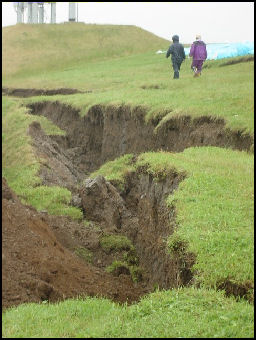
Hokkaido 2003 An 8.2 earthquake in Hokaido in 1952 and an 8 earthquake in 1843 caused tsunamis between four and seven meters (See Tsunamis). An earthquake in Kuril Islands in Russia and Hokkaido in Japan 1994 caused $11.7 billion in damage (See Russia).
On September 26, 2003, a powerful earthquake struck eastern Hokkaido. Measuring 8.0 on the Richter scale, the quake was located 50 miles off shore and 30 miles below the surface of the sea. A total of 573 people were hurt; 41,000 were evacuated; an oil refinery caught fire; and a train derailed. The main earthquake was followed by a strong earthquake measuring 7.1 on the Richter scale. Much of the damage was caused by a tsunami that reached a height of 1.2 meters in Kushiro in Hokkaido. The tsunami hit about one hour after the earthquake. One man told the Daily Yomiuri, “When a big wave approached the port, I thought it would swallow me and my car whole.”
In November 2006, tsunami warnings were shown repeatedly on televison after an 8.1 earthquake occurred in the Russian-held islands north of Hokkaido. The tsunamis ended up being only a 40 or 50 centimeters high at their highest and few people — even those living in area deemed most dangerous — heeded the warnings and headed for higher ground or shelters. A larger tsunami generated by the same earthquake traveled clear across the North Pacific and produce a 1.8 wave in California and damaged docks and overturned one boat.
In January 2007, an 8.2 earthquake occurred off the coast of Hokkaido about 100 kilometers from the spot 7.9 earthquake occurred in November 2006. . tens of thousands of residents were ordered to seek higher ground in the event of a tsunami. Tsunami warning were issued on television and radio but were widely ignored. The tsunami that hot Hokkaido was only around 20 centimeters high at its highest. It was predicted to be a meter high.
Earthquakes in Niigata and the Sea of Japan
Major earthquakes along the Sea of Japan have included the Nihonkai Chubu Earthquake in May, 1983 which killed 104 and injured 163; the Niigata Earthquake in June, 1964, which killed 26;the Niigata Earthquake in October 2004 (See Below); the Noto Peninsula Earthquake in March 2007 (See Below); and the Niigata Earthquake in July, 2007 (See Below).
Major earthquakes that have occurred along the Niigata-Kobe belt include 1) the Zenkoji Earthquake (7.4 on the Richter scale) in 1847; 2) the Hietsu Earthquake (7.1 on the Richter scale) in 1858; 3) the Nobi Earthquake (8.0) in 1891; 4) the Eno Earthquake (6.8) in 1909; 5) the Fukui Earthquake (7.1) in 1948; 6) the Niigata Earthquake (7.5) in 1964; 7) the Great Hanshin Earthquake (7.3) in 1995; 8) the Niigata Earthquake (7.4) in 2005
Experts attribute the high number of earthquakes in the Niigata area to a tectonic belt with a high concentration of seismic strains. The existence of the belt was only revealed in 2001. In this area land and sea plates are pushing against each other about two centimeters annually, 10 time the rate in surrounding areas. Within the area are a number of faults on which several shallow earthquakes with a high intensity have occurred. Earthquakes in the Niigata area have been tied to rising bubbles of magma, topped by pockets of water, which affects slippage on the faults above them, causing earthquakes.
Niigata Earthquake of 2004
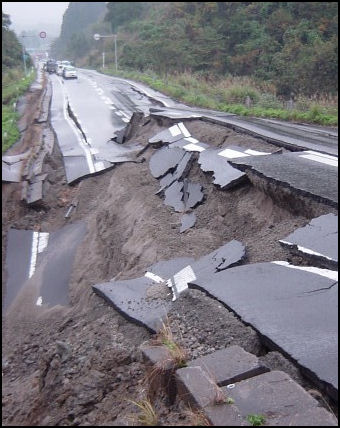
At 5:56pm on October 23, 2004, an earthquake measuring 6.8 on the Richter scale hit the Chuetsu region of Niigata prefecture. A total of 67 people died and 4,805 were injured. About 13,000 buildings were destroyed or severely damaged and more that 100,000 people were evacuated. The 6.8 earthquake was one jolt in series of seven earthquakes that occurred over a two hour period that were followed by a series of aftershocks, some of them quite strong, that continued into December.
The Niigata quake in 2004 was the worst since the Kobe earthquake in 1995. It was a reverse fault earthquake in which a fault slips under force from both sides and one chunk of land overlaps another other. The epicenter was close to bedrock, which minimized the vibrations over large area. The high number of aftershocks was due to the high number of fault lines that run through the area,
Highways buckled. Roads caved in or were blocked by landslides. Electricity and telephone service was cut off. Fires were ignited by gas line leaks. Entire villages were flattened. Other had to be completely evacuated out of concern they might be buried in landslides or floods caused by water breaking through natural dams made by landslides from the quake.
People were airlifted out in helicopters. Hospitals were overwhelmed and patients were treated in waiting rooms. Evacuees were put up in 500 makeshift evacuation shelters, such as school gymnasiums and municipal sports hall, where they endured long bathroom lines and shortages of food. Some people slept outside and had nothing to eat or drink for several days.
Damage from the Niigata Earthquake in 2004

The earthquake in Niigata 2004 caused $28 billion in damage. It occurred just days after the area was struck by the worst typhoon in a decade, which saturated the ground and increased the number of landslides and mudslides. One survivor told NHL, “I ran outside and when I looked at buildings, they were shaking like pudding.”
A total of 3,791 landslides were set off by the quake, moving 100 million cubic meters of soil, enough to fill Tokyo Dome 80 times; 2,753 points on national, prefectural and municipal roads were damaged by landslides; rivers were blocked in 52 places by landslide dams. One such dam comprised of 1.29 million cubic meters of soil was 30 meters high. The government decided to leave the dam as was because it would to expensive to move. Water behind the dam was removed with a makeshift drainage system but even after that the water was 15 meters deep in some places.
One of the worst hit towns was Ojiya, about 160 miles northwest of Tokyo.”On the ground in Ojiya,” James Brooke wrote in the New York Times, “land under a rail line had caved in, forming a crater-like hole and leaving train tracks dangling in the air...Overturned cars scattered around a 33-foot crater carved from a shattered highway...Parts of three expressways were closed because of a crumble overpass, a collapsed highway tunnel and cave-ins on many secondary roads.”
The village of Yamakoshimure was evacuated because it was threatened by a quake lake produced by a dam that was created by a landslide caused by the liquidization a mountain slope. Water backed up from a river behind the dam flooded fields and houses. There were worries the dam might burst and inundate villages and towns downstream. Pumps, pipes and drills were used to drain some of the water. Worries increased after heavy snowfall in the winter and spring melting.
One year after the earthquake rivers were still blocked, 9,000 people still lived in temporary residences, 20 percent of the secondary roads were damaged; and many of the rebuilding projects had not begin. Families were forced to abandon 100-year-old homes because roads had not been rebuilt and people couldn’t return to their homes,
Radioactive water spilled at Kashiwazakai-Kariwa nuclear power plant during the quake which was not strong to automatically shutdown the reactors.
Death and Injuries from the Niigata Earthquake in 2004
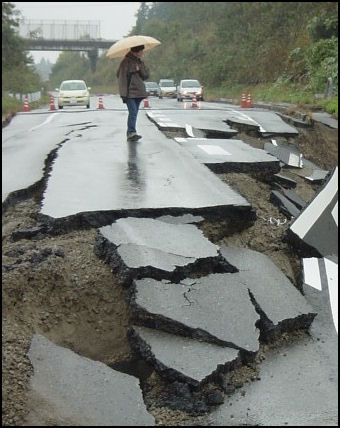
Many of those who died were buried in landslides or crushed under falling walls or collapsing houses. Some died from deep-vein thrombosis (economy-class syndrome) after being forced to sleep in their cars after being evacuated. Many of the dead were elderly. One man died when tubes connecting him to an artificial respirator were dislodged. Several elementary-school-age children were killed. Three children in Ojiya were killed when their house collapsed,
Most of the who were injured were hit by falling furniture and other objects in their houses. Only seven percent were injured when their houses or buildings collapsed.
Four days after the first quake, a two-year-old boy was found alive inside a van buried by an earthquake-induced landslide. The boy’s mother and three-year-old sister who were also in the car did not survive. The boy was outside the car in a space between the car and a large rock. He was dehydrated and suffering from hypothermia but otherwise was in surprisingly good condition. He survived because the earth around him kept him warm and he was small and didn’t need much oxygen.
Economic and Infrastructure Damage from the 2004 Niigata Earthquake
During the first Niigata quake a Shinkansen bullet train derailed. It was the first time since the high-speed train was introduced that one derailed. About 150 people were on the train at the time. None were injured even though it was traveled at 125mph when the quake struck and was rocked from side to side by the quake. While the train was being put back on the track with a crane another earthquake hit. Full services was resumed 66 days later.
By some estimates the earthquake caused $13 billion in economic damage because of delays and lower production. Factories in Niigata that produce fine fabrics and precision equipment were forced to shut down. A large Sanyo chip-making plant was shut down. Sanyo had originally planned to post record profits but the earthquake caused it to post loses for the year. Matsushita and Sharp factories in the area were also affected.
Many rice farmers suffered damage to their crops. Around 1.2 million ornamental carp and 16 fighting bulls were killed. Many of the fish died because the landslides contaminated their ponds or power outages stopped their water filtration systems in their tanks.
Many victims found that the cost of rebuilding after the quake was too much. In a typical case a man who was still making mortgage payments on a house that was destroyed was burdened by payments of over $1,000 a months for a $100,000 loan on his rebuilt house. The man did not receive government assistance because his income was over $50,000 a year.
See Bullfighting
Earthquakes on Kyushu and the Noto Peninsula
In March 2007, there was an earthquake on the Noto peninsula on the Japan Sea side of Japan. It measured 6.9 on the Richter scale and killed one person, destroyed 59 buildings and damaged 830 others, including a number of shrines and temples. Strong aftershocks forced many people to sleep outside in the days that followed the earthquake.
The epicenter of the earthquake was 10 kilometers below the sea surface off the western coast of the Noto peninsula. It was most likely triggered by an active fault located off the peninsula, whose existence was not known until after the quake.
The earthquake occurred at 9:42am. One reason why the casualty figures were so low was that the quake occurred after breakfast when many people had already left their homes. The casualty and damage figures were also said to be low due to lessons leaned from Kobe and Niigata earthquakes such as taking measures to reduce the chances of fire and building collapse.
Wajima was the hardest hit town. Many of the worst hit areas were inhabited by elderly people. An effort was made to make sure these people had good medical care and were cared for if they had been evacuated from their homes.
In March 2005, an earthquake measuring 7.0 on the Richter scale struck off the coast of northwest Kyushu, killing one person and injuring 250. The epicenter was at a shallow dept of nine kilometers below the ocean .Trains service was halted. Buildings and power lines were knocked down. Glass broke out from tall buildings. People were trapped in elevators, A 74-year-old woman in Fukuoka was killed when a wall collapsed on her. Damages was particularly heavy on Genkaijima Island, where several houses collapsed and 700 people were evacuated, in Fukuoka Bay.
Niigata Earthquake in 2007

On July 16, 2007, an earthquake measuring 6.8 on the Richter scale struck Kashiwazaki in Niigata Prefecture, killing 15 people, injuring 2,300 and damaging 14,000 homes. Cracks opened up on roads and major expressways. A fire broke out at a nuclear power plant. Tremors were felt as far away as Tokyo. Damages from the quake were estimated do be around ¥1.5 trillion.
Utilities were cut in many places. Gas, electricity and water supplies to tens of thousands of households were disrupted. Traffic was crazy as stop lights went down. Some Shinkansen services resumed after 30 minutes. Others were shut down for days. Landslides were more numerous than they otherwise might have been because of heavy rains that occurred before the quake.
The focus of the earthquake was about 17 kilometers underground off the coast of Niigata Prefecture, about 40 kilometers northwest of the epicenter of the 2004 earthquake. The 2007 earthquake was similar in size to quake that struck Niigata in 2004 but appears to have occurred along a different fault, whose existence known because it was in the sea, The intensity of the 2007 quake was magnified by soft sediments around the epicenter.
The 2007 earthquake occurred at 11:20am. One man told the Daily Yomiuri “It felt stronger than the Niigata Earthquake” in 2004. “I couldn’t stand still...I had to hold on the greenhouse. Many tiles fell from the roof, and my neighbors ran out of their home.” Aftershocks continued to hit the area during the day. A strong temblor that registered 6 on the Richter scale struck at 3:37pm. Rains, high humidity and high temperatures made life hard for people without electricity or stuck in shelters.
The heaviest damage was in the Kashiwazaki area. Most of the dead were elderly people in their 60 and 70s. Six victims were buried under the rubble of collapsed buildings, many of them old houses with heavy tile-covered roofs that literally crushed the structure, One woman died when a kimono fabric shop collapsed on her despite a seven hour rescue effort that began when someone heard the woman’s voice and saw her hand sticking out the rubble. The rescue operation involved tying the shop to a traffic light to keep it for collapsing further and using chainsaws to make a hole in a wall.
Troops in n the Japanese military were sent to area to help rescue people trapped under collapsed buildings, supply water and repair roads damaged by landslides, Disaster volunteers, many from outside the Niigata area, showed up in such large numbers some places were overwhelmed by them,
Affects of Niigata Earthquake in 2007
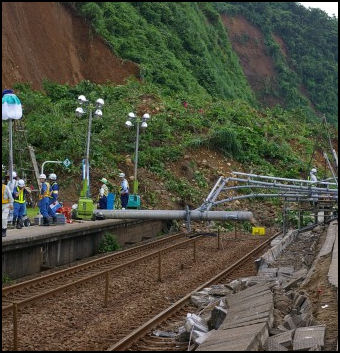
Over 40,000 people were still without water three days after the earthquake because of damage to aqueducts and water purification plants and pipes that carry water to households. Some people collected rain water to drink. Some places didn’t have their water restored until weeks later.
Four days after the quake, 26,000 people were still in earthquake shelters, complained of sweltering conditions. Water had to be trucked in. Portable toilets were used because flush toilets were not working. Water shortages raised concerns about the spread of disease.
Trains service on parts of the Shintetsu Line in Niigata were suspended for several day. Rails that were disrupted by the quake had to be fixed and a station that partly buried by a landslide had be dug out. It several days to mount an operation to right a derailed train.
Niigata Earthquake in 2007 and the Automobile Industry
The earthquake affected he automobile industry by closing or slowing suppliers whose factories were damaged by the quake which in turn forced the temporary closure of some assembly plants that relied on parts from these suppliers. Toyota was forced to halt production at all of its plants for two days ands saw production drop 9.5 percent for the month, showing vulnerabilities of the “Just in time” production strategy.
The closure of an auto parts plant that made piston rings in Kashiwazaaki affected the production of engines outside the region and that in turn affected the making of cars, and caused all 12 Japanese car makers to shut their production lines. The plant, owned by the Riken Corp., makes 50 percent of the piston rings for the Japanese market The rings are made to very precise specifications. Bringing in other manufacturers would require Riken to reveal production secrets.
Automakers production fell by 120,000 units. Toyota alone had to suspend operations at 30 plants because of the piston ring shortage. The automakers dispatched a huge number of employees to the Riken plant to get the plant back in operation, a goal that was achieved in less than a week after the earthquake. A number of other factories and businesses were also affected.
Nuclear Power and the Niigata Earthquake in 2007

At the time of the earthquake three reactors at Kashiwazakai-Kariwa nuclear power plant in Niigata were operating at full power and one was in start up mode. These four nuclear reactors — Nos. 2, 3, 4 and 7 — shut down automatically because of the earthquake; heat was removed from the cores; and radioactive materials were confined. The force of the quake was so strong that roads within the power plant grounds buckled to such a degree that cars could not pass. The other three reactors were not operating because they were undergoing scheduled inspections at the time of the quake.
The safety system , including the “shutdown,” “cooling and “containment” operations, performed according to plan. At the time of the quake the control rods were fully inserted . After the initial shutdown attention was devoted to cooling the reactor water from 286 degrees C to less than 100 degrees C, something that took 21 hours to achieve.
Kashiwazakai-Kariwa nuclear power plant is the world’s largest nuclear power plant. It covers 42.2 square kilometers and has a capacity of 8,212 MW and supplies nearly 20 percent of the electricity for the greater Tokyo area.
The fault that caused the earthquake goes directly under the nuclear power plant and had not been detected until the earthquake occurred, The inability of TEPCO to find the fault and predict that high intensity earthquakes would occur there worried many. TEPCO admitted it didn’t find the fault but said there was no serious danger because the fault was too deep — 12 miles under the surface — to cause the kinds of crack that could damage the thick concrete buildings that surround the reactors.
Problems with Nuclear Power and the Niigata Earthquake in 2007
A small fire broke out in an electricity transformer of the No. 3 reactor, sending black smoke billowing into the air, but no damage was reported to the reactor. A small amount of coolant containing radioactive material leaked from the No. 6 reactor. Images of a fuel-storage pool in reactor No. 3 show meter-high waves generated by the quake sloshing outside the pool.
The plant was designed t withstand short, intense tremors not the broad, horizontal swaying that occurred with the 2007 earthquake This caused water to slosh out of storage pools, with around 1,200 liters contaminated with small amount of radioactive material reaching the Sea of Japan.
At least 63 other problems were reported, including burst pipes, water leaks, and radioactive waste spillage. In five of the reactors major exhaust pipes were knocked out of place. About 100 drums containing radioactive water fell over. Some of them were found with their lids open, Small amounts of cobalt-60 and chromium-51 leaked into the atmosphere.
All these problems were an embarrassment for a nation that touted its nuclear reactors as being earthquake proof. Three days after the earthquake the Niigata government ordered Tokyo Electric Power Company (TEPCO), the owner and builder of the plant, to shut the plant down. The earthquake also raised concerns about Japan’s 48 other nuclear reactors, many which are situated in earthquake-prone areas. Lawsuits were filed seeking the closure of at least four plants because they are located near faults. They include one in Shija in western Japan, where are large vault was found in 2005.
The shut down of the plant caused strains on Japan’s electricity-generating system and caused power shortages. Electricity generated by nuclear power decline from 69 percent to 63 percent with the loss of Kashiwaszaki-Kariwa nuclear power plant. TEPCO took emergency measures for the first time in 17 years to meet electricity demand during the height of the heat wave in August 2007 because the Kashiwazakai-Kariwa nuclear power plant was still down.
The Kashiwazaki-Kariwa went online in May 2009 for the first time since the earthquake.
Image Sources: Earthquake Image Archives M. Yoshimine, Tokyo Metropolitan University except Tepco (Kashiwazaki Kaiwa nuclear plant)
Text Sources: New York Times, Washington Post, Los Angeles Times, Daily Yomiuri, Times of London, Japan National Tourist Organization (JNTO), National Geographic, The New Yorker, Time, Newsweek, Reuters, AP, Lonely Planet Guides, Compton’s Encyclopedia and various books and other publications.
Last updated March 2010
